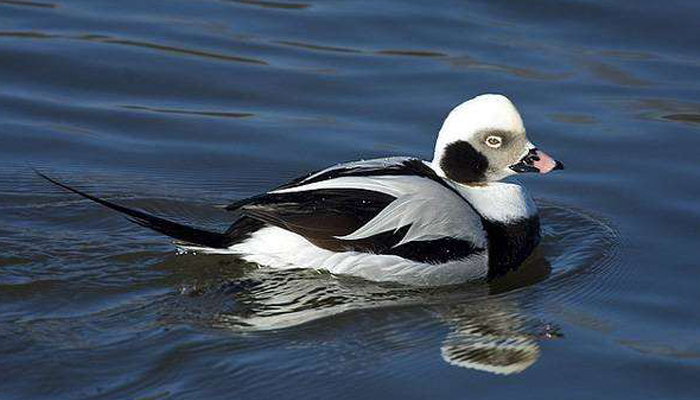
English: Long-tailed
Duck, Oldsquaw
Russian: Морянка
German: Eisente
French: Harelde boreale
Mongolian: Мөнгөлөг шунгаахай
Japanese: コオリガモ (Kori-gamo)
Body length: 39-47 cm
Wing span: 65-82 cm
Habitat: Breeds
commonly in the Arctic on Tundra pools and marshes, also along sea coasts and
on still-standing mountain waters. Gregarious. Winters at sea, often in large,
dense flocks, mainly off coasts; then restless and active, taking off and
flying agilely, low over the water, in short pursuit-flights, constantly
changing direction, landing with splash; dives for molluscs and other animal
food. Spring migration through Baltic spectacular; main exodus from Gulf of
Finland to tundras in NE on late-May evenings with tail-wind, involving over
100,000 birds on peak days. Complex moult produces at least three
different-looking plumages annually; most scapulars and feathers of sides of
head and neck are moulted three times a year, breast, upper mantle and rest of
head and neck twice, and rest of plumage once a year.
Identification: Rather
small, brown, black and white duck. Head rounded, bill short and stubby,
central tail-feathers of ♂ elongated to thin line. Wings rather narrow and
pointed, all dark, wingbeats fast and elastic, mainly below horizontal, adding
to peculiar, almost but-like impression, and wings slightly swept back.
Plumages and moults complex.
- Adult
♂ spring/summer: Largely brown-black with grey-white flanks, white stern and
white patch at side of head; scapulars blackish, edged rufous-yellow. Summer
moult to full eclipse during later stages of breeding changes little in
appearance (new scapulars shorter and duller). Bill has pink band across centre
in spring, is often all black in summer.
- Adult
♂ autumn: Becomes much whiter; upper mantle, most of scapulars, neck and head
white, sides of lower head/upper neck with dark patch. Bill acquires pink band
again.
- Adult
♂ winter: As in autumn, but forehead and sides of head pale grey-brown, not white,
and patch on side of head/upper neck black (with chestnut lower rim), not
mottled brown-grey.
- Adult
♀ summer: Like adult ♂ but lacking elongated tail-feathers, and colours duller,
also, pale patch on side of head narrower and less sharply set off, and invariably
a light collar around neck.
- Adult
♀ autumn/winter: Main difference from summer is head, which is off-white with blackish
crown and patch at lower cheek/upper neck; scapulars are longer and edged more
brightly rufous-buff (or even partly whitish).
- Juvenile:
Like adult ♀ autumn, but with less dark and distinct patch at lower cheek/upper
neck, and with shorter and blunter tertials and scapulars.